
Last week, I met a most intriguing sales person.
He turned up at our door, beaming, and told us that he knew (how on earth?) that our regular water-can supplier had ditched us this week, to go to his village.
Then, he cheerfully informed us that we need to try his water-can service – because his ‘customer care’ was better.
Yes, those were his exact words, and he went on to explain how.
For starters, he took orders through WhatsApp. Besides, he had a Dominos inspired 1 hour or free guarantee for his water can. Most importantly, his clients didn’t have to live off 1 litre bottles in his absence, because he had an assistant.
Now if there was one thing I thought could never be ‘marketed’ to me, it was water. But there you go – on the sole promise of great customer service, this guy had us sold!
It’s no secret that today, when one unhappy comment on the internet can tear your reputation apart – customer service, especially on social networks, is a big deal. And to make sure you don’t mess it up, here are 7 tips that you need to keep in mind!
1) Maintain a 100% Response Rate
According to Gigya, today’s connected customers want their online questions to be answered promptly – in fact, 42% expect a reply within 1 hour!
If you’re selective or slow while responding online :-
- You run the risk of losing engagement (why will a customer take the trouble of complimenting you, when you haven’t replied to the last 10 posts on your page?).
- You come across as lethargic or unconcerned about what your customers and prospects have to say to you.
Make it a habit to respond always and quickly.
On Facebook, reply to the comments on your posts, the ‘reviews’ and ‘visitor posts’ on your page, and the messages in your inbox. On Twitter, don’t just answer those who @mention you or send you a Direct Message – instead, save a search for your brand name, and try and respond to everyone who’s tweeting about you. However, make sure you don’t barge into conversations between other people where they ‘happen’ to mention your brand. That will seem rude (also creepy).
2) Monitor your page for spam
Once your page becomes popular, it will be strewn with spam comments about working only 1 hour a day and making 1 million a month..and so on!
While it is usually not possible to weed out such comments entirely, make sure your team works proactively to delete them on posts where you are specifically asking for engagement (for example, a contest, or feedback on a new product, etc), so that customer experience is not compromised.
3) Encourage positive engagement from customers
According to the White House Office of Consumer Affairs, news of negative customer service is likely to reach twice as many people as news of positive customer service. This means that an unhappy customer tends to be more vocal than a satisfied one.
For any large business, that can result in a distorted perception to outsiders (more negative feedback than positive). Make customer engagement a part of your social media strategy, and encourage people to share their positive experiences with your company (through contests, by sharing such stories on your own blog and media, etc.).
4) Avoid directing people to other channels
Unlike your social media pages, the phone number or email address on your website looks faceless and impersonal to your customers. They come to your social pages because they want to ‘directly’ interact with your brand – not with someone at a call center.
Unless you absolutely cannot, try to answer people where they’ve asked their question!

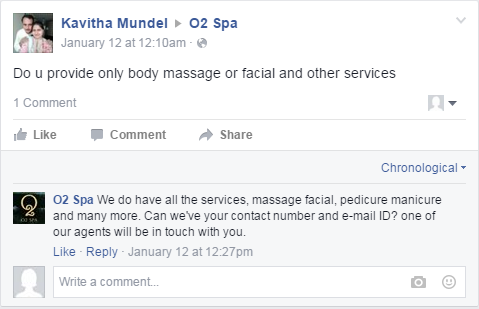
Don’t tell them to dial your helpline number, or email your generic customer care ID. Instead, aim to make the whole process of customers getting their issues resolved as simple, straightforward and painless as possible.
5) Deal with criticisms maturely and politely
Your being on social media has turned the balance of power in the favour of your customers! One small folly, and you could get pounced on. Often, the comments that you’d need to tackle will be unreasonable, or unreasonably expressed.
Make sure you maintain professionalism, and respond to each criticism/complaint with courtesy.
Deleting angry posts, in particular, is a big no-no, and not just for the sake of ethics. A customer who’s post was deleted is likely to publicize this fact further, spelling more damage to your reputation. Consider an example :-
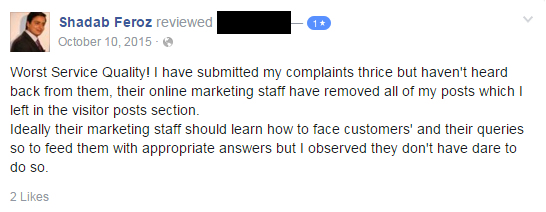
6) Ensure closure for every online conversation
Often, when you’re resolving issues through public comments on your social media, you direct the conversation to private messages (when exchanging sensitive information like contact numbers, etc.).
Once the issue has been resolved privately, make sure you publicly close the conversation as well. You need to do this so that others who are looking at your profile, do not get the wrong impression that you left things hanging in the air.
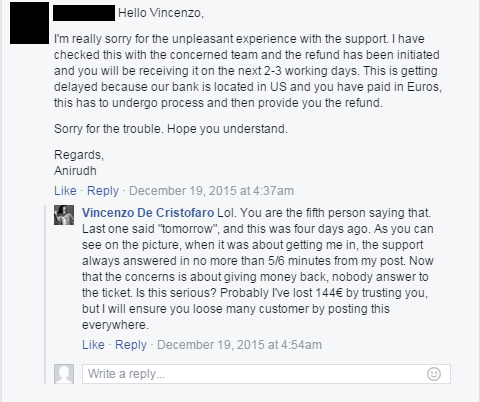

7) Infuse personality in your communication
Most companies try to have a distinct ‘voice’ on social media, which is in line with their overall branding. For example, Innocent Drinks is famous for the understated wit and humor it’s posts are always full of :-
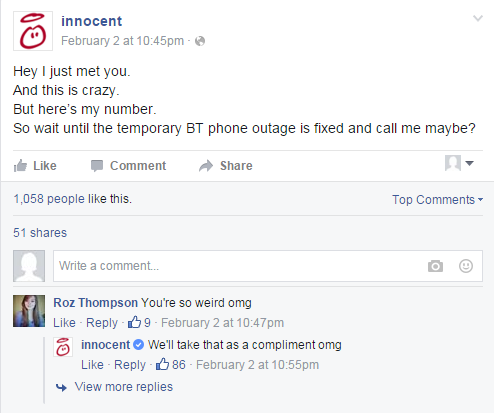
However, not many companies extend this ‘voice’ to their customer care messages, and that is a mistake. It creates inconsistency, dilutes the impact of your branding, and might even make it seem ‘fake’.
Ditch the ‘we’ll look into your concerns’ tone, and infuse your messages to your customers with some personality! Here’s a great example from Innocent Drinks, again :-
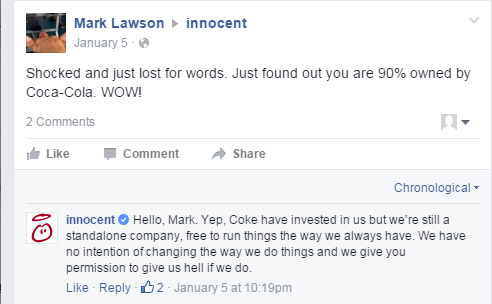
And that’s all you need to know! Go woo that angry customer back :)








